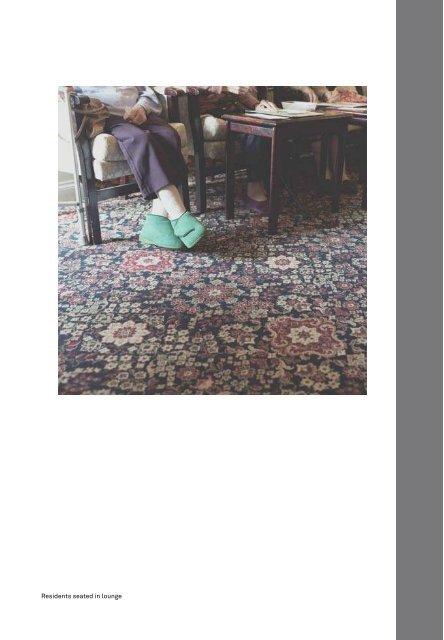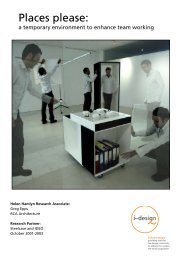Design for Dementia - Helen Hamlyn Centre - Royal College of Art
Design for Dementia - Helen Hamlyn Centre - Royal College of Art
Design for Dementia - Helen Hamlyn Centre - Royal College of Art
Create successful ePaper yourself
Turn your PDF publications into a flip-book with our unique Google optimized e-Paper software.
CONTEXT<br />
WHAT IS DementiA?<br />
<strong>Dementia</strong> is an umbrella term used to describe the symptoms that<br />
occur when the brain is affected by a number <strong>of</strong> conditions, most<br />
commonly alzheimer’s. Symptoms <strong>of</strong> dementia include loss <strong>of</strong> memory,<br />
mood changes and communication problems and people affected<br />
will typically experience a decline in the ability to talk, read and write.<br />
<strong>Dementia</strong> is progressive, meaning that the symptoms will<br />
gradually get worse. A person in the later stages <strong>of</strong> dementia will have<br />
problems carrying out everyday tasks <strong>of</strong> daily living and will become<br />
increasingly dependent on other people.<br />
In care homes, staff training and well-designed physical<br />
surroundings are important. They <strong>of</strong>fer a framework <strong>for</strong> people with<br />
dementia to maintain their existing skills, create opportunities <strong>for</strong><br />
meaningful engagement between residents and staff and greatly<br />
affect quality <strong>of</strong> life.<br />
Why <strong>Design</strong> For <strong>Dementia</strong> IS Important<br />
–<br />
1.,2. Samantha Sharp,<br />
Home from Home: A Report<br />
Highlighting Opportunities<br />
<strong>for</strong> Improving Standards<br />
<strong>of</strong> <strong>Dementia</strong> Care in Care<br />
Homes, Alzheimer’s<br />
Society, 2007, p4<br />
Two-thirds <strong>of</strong> the population <strong>of</strong> care home residents in the<br />
UK have a cognitive impairment. 1 <strong>Dementia</strong> is the strongest<br />
determinant <strong>of</strong> entry into residential care <strong>for</strong> people aged<br />
over 65. 2 These figures are likely to rise as the population<br />
ages thereby creating more demand <strong>for</strong> facilities and as<br />
new drugs are introduced to slow but not cure the progression<br />
<strong>of</strong> the disease.<br />
The quality <strong>of</strong> dementia care in the UK varies, ranging<br />
from excellent, through mediocre to neglectful. Only 60%<br />
<strong>of</strong> individuals in care are currently staying in dementia<br />
registered beds specifically geared towards their high<br />
level <strong>of</strong> needs. Reports from organisations such as the<br />
Alzheimer's Society suggest that many homes are not<br />
providing an appropriate level <strong>of</strong> person-centred care.<br />
Problem areas including the provision <strong>of</strong> activities, the<br />
treatment <strong>of</strong> residents with dignity and respect, and the<br />
relationship between homes, relatives and friends.<br />
A key issue in improving care is to better understand<br />
how the design <strong>of</strong> care home environments impacts on<br />
the quality <strong>of</strong> care. Features, layouts and facilities can<br />
help to maintain a resident’s remaining strengths, improve<br />
working conditions and provide a better care culture<br />
<strong>for</strong> staff, residents and visitors alike. This publication<br />
explores the role design can play in improving care homes,<br />
presents an understanding <strong>of</strong> residents’ needs and gives<br />
a design perspective on dementia.<br />
Residents seated in lounge<br />
13

















